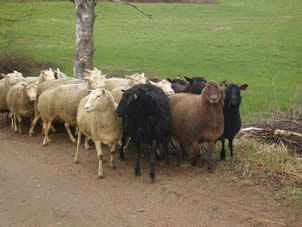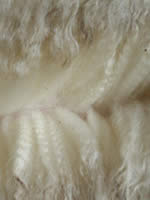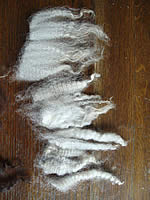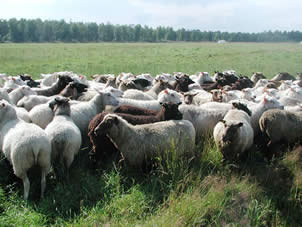
| ASSOCIATION HISTORY PRODUCTION
TRAITS WOOL CONTACT |
|
| |
|
WOOL, THE RENEWABLE NATURAL RECOURCE |
|
Finnsheep wool has always been a
much desired raw material with both handcraft and arts and crafts
manufacturers. Finnsheep wool is almost free from kemp wool.
Special qualities
• lustre
• resilience
• evenness
• softness
• lightness
• vivid surface
• semi fine
• good felting qualities
Colours
• wide natural colour spectrum
• pure white
• deep black
• different shades of brown
• blending possibilities of the natural colours are limitless
|
 |
| |
|
| |
|
| |
|
Finnsheep wool traits |
|
In the picture: Places for taking
the wool samples and grading of the wool: 1, 2 and 3.
Grading quality (With scale 46 – 60)
• 53-54
• Wool is finer from the shoulder area and coarser from
the thighs.
Crimp frequency ( / 3 cm)
Embodies the fineness of the wool.
• White and brown wooled animals have in average 6 – 7
staples. Black wooled have in average 5 – 6 staples.
• The degree of hereditary (h2) for the wool crimp is 0,49.
Staple length (The average of three measuring points)
• The average staple length 7 cm, the shortest staple being
2 cm and the longest 18 cm.
• The hereditary degree (h2) for the staple length is 0,66.
Diameter of the wool fibre
This is the most determinative factor of the wool quality.
• The minimum requirement of fine wool fibre is 21 µm.
When 22-23 micron wools are mixed into the fine wool, it is said
to better the resilience of the final product.
• 25,9 microns (the range being from 21,4 microns to 37,0
microns).
• The degree of hereditary (h2) for fibre diameter is 0,47.
Fleece weight
• An adult sheep produces about 3,0 kg wool / shearing.
• Lamb’s wool clip is about 1,0 kg. Age of the lamb
being 154 d, about 5,5 months.
• Wool clip of the white sheep is a bit larger that the
wool clip of the coloured sheep.
• Finnsheep wool is light in grease. The scouring loss is
only about 30 % - 35 %.
• A Finnsheep ewe produces carded fleece about 1,2 kg -
2,5 kg.
|

 
|
| |
|
| |
|
| |
|
Hereditary of the wool quality |
|
The wool quality traits are inherited
rather well, except for the lustre and uniformity of the wool.
The strongest hereditary connection is between the wool crimp
and the grading quality of the wool. Also the wool crimp, the
grading quality and the staple length are closely connected.
The curlier the wool, the shorter and denser it is. As the
crimp frequency / 3 cm increases, the diameter of the wool
fibre decreases. The staple formation and the lustre are also
nicely hereditarily connected to each other.
|
 |
| |
|
| |
|
| |
|
The breeding objectivities of
Finnsheep wool |
|
Finnsheep’s wool quality
evaluation and breeding objectives are joint Nordic.
| Colour |
Pure white, deep brown and black.
Same objectives for all of the colours. |
| |
|
| Woola |
Wool Even conformation of the wool
Lustrous, soft and curly
Wool crimp 6 – 9 / 3 cm
Staples distinct and tapering
Grading quality 54 or over or < 26 µm
Length at six months of age 6 cm
No kemp wool nor guard hairs
Good wool yield |
|
 |
| |
|
| |
|
| |
|
Use |
|
Lamb’s wool is well suitable
on products which are used straight next to your skin, like
knitted garments, soft blankets, shawls and children’s
clothing. Yarn made out of lamb’s wool can be used on
baby’s garments and instead of rheumatism or alpacayarn
on scarves and warmers. Yarn spun from adult Finnsheep wool
is suitable for interior decorations, garment fabrics and knitted
products.
One of the specialties of Finnsheep wool is its’ excellent
felting qualities. It felts well and with ease.
|
 |
| |
|
| |
| |
|
Literature sited: |
|
| Puntila M-L. 1997. |
Selection criteria and fleece
characteristics for the Finnsheep. Newsletter of the European
Fine Fibre Network, issue 2, December 1997:5. |
| Puntila M-L., Nylander, A., Nuutila, E-M. |
Genetic parameters
for wool traits in Finnsheep lambs. The 50th Annual Meeting
of the European Association for Animal Production, August
1999, Zurich, Switzerland. Book of Abstracts 5: p.264. Mimeogr.
8p. |
| Puntila, M-L., Nylander, A. ja Nuutila, E-M. 2000. |
Lampaan
villaominaisuuksien jalostusohjelman kehittäminen. Maataloustieteen
päivät 2000. Kotieläintiede: 227-230. |
| Silvola, R. ja Puntila M-L. 2000. |
Fine Finnwool-projektin
loppuraportti. Lounais-Suomen Käsi- ja Taideteollisuusoppilaitos
Aikuiskoulutus, Mynämäki. s. 40. |
|
| |
|
| www.finnsheep.fi © Finnsheep r.y.
r.f |
|
|
|
